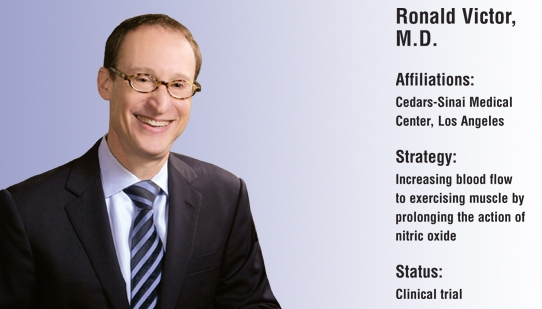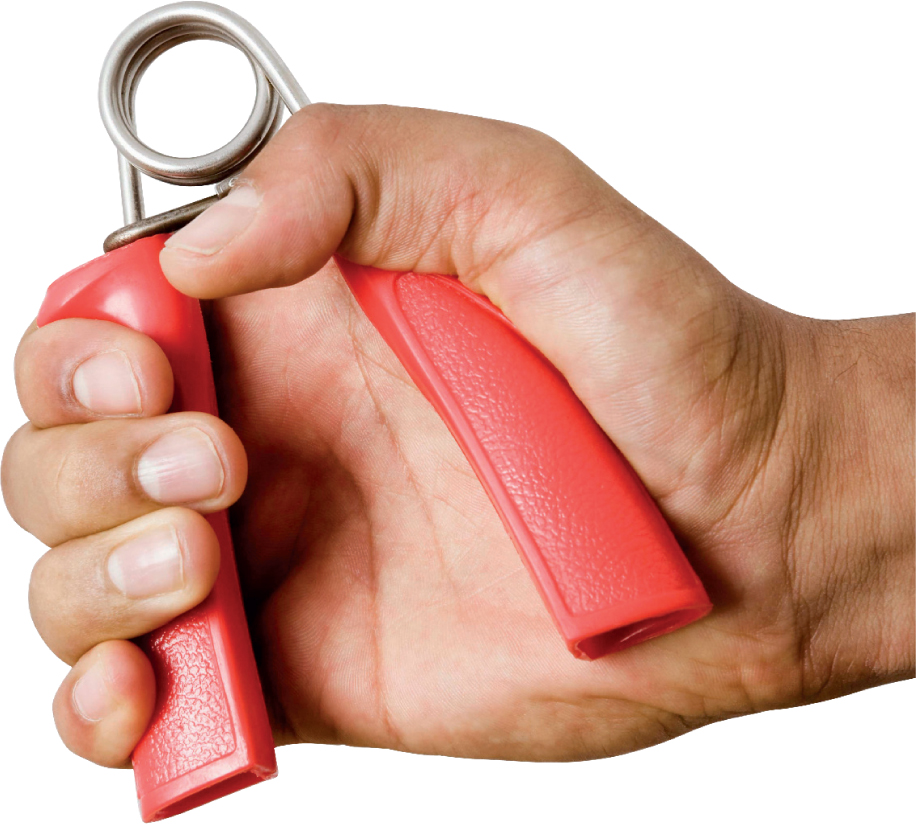
Enhancing Blood Flow to Exercising Muscles

Ronald Victor admits it: He never set out to study muscular dystrophy. As an adult cardiologist specializing in hypertension (high blood pressure) and neurologic control of cardiovascular mechanisms, he’s a relative latecomer to the muscle field, but far from a reluctant one.
Victor, who’s now associate director of the Cedars-Sinai Heart Institute and director of the Cedars-Sinai Hypertension Center in Los Angeles, has been interested for decades in how the body allocates blood supply to various tissues under different conditions — something that’s largely under the control of the autonomic nervous system.
‘Fight or flight’ vs. ‘rest or digest’
The autonomic nervous system, Victor explains, has two divisions, the sympathetic and the parasympathetic. The sympathetic division can be thought of in a general way as helping the body to mount a “fight or flight” response, with an overall increase in heart rate and blood pressure. Pressure increases because blood vessels constrict under sympathetic stimulation.
The parasympathetic division directs the body toward a “rest or digest” mode, generally decreasing heart rate and blood pressure. Under parasympathetic stimulation, blood vessels normally dilate, increasing blood flow but lowering pressure.
In the 1980s, when Victor was training to be a cardiologist at Duke University, physiologists remained somewhat puzzled by the fact that part of the “fight or flight” response involved vascular constriction (vasoconstriction) in some parts of the body, with increased blood flow (apparently vasodilation) in the parts where more blood was needed.
Figuring out how the body manages to constrict blood vessels in some locations and at the same time open them in others was a challenge Victor wanted to meet.
Special blood delivery to working muscles
As he began to research the subject, Victor discovered a 1962 paper describing a phenomenon in laboratory animals called “sympatholysis” — blocking of sympathetic nervous system stimulation — during exercise.
They didn’t know what the molecular mechanisms were, but the paper’s authors observed that, at least in dogs, sympathetic stimulation resulted in constricted blood flow and increased blood pressure in general, including to the legs, if the dog was at rest; but that sympathetic stimulation was accompanied by dilated blood vessels and increased blood flow if a limb was exercising.
Victor’s own experiments showed the same mechanisms seemed to be operating in exercising versus resting human subjects. “If you’re exercising on a stationary bike, holding on with your arms, the body wants to constrict blood flow to the arms because that helps keep blood pressure up so you don’t pass out when you exercise,” Victor explains. “But at the same time, blood flow has to be directed to your exercising legs, because those muscles need oxygen from the blood.”
‘Dilator’ chemicals released in muscles
In the 1980s, Victor was part of a research team that developed an accurate, noninvasive way to measure sympathetic nervous system activity via surface electrodes.
“It turned out to be a wonderful technique to understand how the skeletal muscle blood flow is regulated during exercise,” he says.
In 1986, Victor joined the faculty at the University of Texas Southwestern Medical School in Dallas, where he continued his blood flow research until moving to Cedars-Sinai in 2009.
“We started with rat studies,” he says of blood flow and exercise studies conducted in the early 1990s in Dallas. “In exercising skeletal muscle, it was becoming clear that the sympathetic nerve fibers lose their ability to constrict the blood flow because the working muscles are releasing some dilator chemicals. We wanted to figure out what those chemicals were.”
The main one, the team found, was nitric oxide, also known as NO, a molecule that was to get a great deal of attention by the end of the decade. NO, it was soon learned, is a gas synthesized by an enzyme called nitric oxide synthase, or NOS. When extra blood flow is needed, NOS produces NO, which signals blood vessels to dilate.
NOS, NO, erections and exercise
NOS and NO are not only important for exercise but are essential to penile erection. Understanding this was the basis for the development of Viagra (sildenafil), first marketed in the United States in 1998 and followed by similar drugs in the “PDE5 inhibitor” class. PDE5 inhibitors prolong the vasodilating effects of NO by interfering with its normal breakdown.
At the same time that the actions of NOS and NO were being studied by researchers in erectile dysfunction, they also were receiving attention from muscle biologists, such as MDA grantee Kevin Campbell at the University of Iowa and MDA-supported James Stull at UT Southwestern.
“It was really wonderful,” Victor says of the 1990s research. “Jim Stull’s lab was around the corner from our lab. He’s a muscle biologist and I’m a cardiovascular person, and we were trying to figure out what nitric oxide was doing in muscle. We worked on the project together.”
Stull and Victor bred mice missing NOS in their skeletal muscles and found they lost the ability to dilate their blood vessels in exercising muscles. “The difference between resting and exercising muscle disappeared,” Victor recalls.
Without dystrophin, NOS is missing in action
It was also during the 1990s that scientists such as Campbell and many others funded by MDA made rapid progress in describing the cluster of proteins at the muscle-fiber membrane: their normal locations and functions, and the consequences of their absence.
A deficiency of the protein dystrophin, part of this multiprotein cluster, had been known since 1986 to be the underlying cause of DMD and BMD.
In the 1990s, it was found that NOS normally is tethered to this protein cluster, and that when dystrophin is missing, NOS isn’t in its proper position either.
The skeletal muscle form of NOS is called “neuronal” NOS, or nNOS. It’s also present in the nervous system.
Victor and his colleagues speculated that at least some of the fatigue, exercise intolerance and muscle damage seen in dystrophin-deficient mice and in patients with DMD and BMD might stem from one of the secondary effects of dystrophin deficiency: loss of nNOS at the muscle-fiber membrane.
Without nNOS at the membrane, they surmised, NO was probably likewise deficient, and therefore the normally expected vasodilation and increase in blood flow to exercising muscles wasn’t happening.
Not enough blood flows to exercising muscles
With Stull and several other researchers, Victor published a paper in 1998 showing that mdx mice (a model of human DMD) shared something with the nNOS-deficient mice they had studied: They lacked the ability to counteract sympathetic stimulation and couldn’t dilate their muscle blood vessels during exercise.
“We followed it up quickly with a parallel clinical study in boys with Duchenne dystrophy,” Victor says. They received help from Susan Iannaccone in Dallas, who had stored muscle biopsy tissue from many patients with DMD. (Iannaccone, a pediatric neurologist, has received MDA research support and is currently director of the MDA Clinic at Children’s Medical Center of Dallas.)
With Iannaccone, Stull, and others, Victor showed in 2000 that boys with DMD experienced the same impairment of vasodilation in skeletal muscles in response to exercise as was seen in nNOS-deficient and mdx mice.
Boys of the same age who had other muscle diseases in which nNOS was properly localized had normal exercise-related vasodilation.
Can a NO boost restore blood flow?
“We thought about blocking the sympathetic nervous system,” says Victor, as a way of restoring vasodilation in exercising muscles in DMD. “But you have to do that locally. You can’t just block the sympathetic nerve fibers generally, or blood pressure would drop.”
If NO were completely absent in skeletal muscle because of mislocalized nNOS at the membrane, then trying to prolong NO’s activity using a Viagra-like drug wouldn’t do any good, Victor reasoned. But if there were some NO being produced, then such a strategy could be considered.
Additional work would show that there is, in fact, some NO being produced in people with DMD or BMD, and that its longevity could therefore perhaps be increased by treating patients with a PDE5 inhibitor.
 Testing tadalafil
Testing tadalafil
In 2010, Victor received an MDA grant to study the effect of tadalafil (Cialis, a Viagra-like drug) on blood flow in exercising forearm muscles in men with BMD.
“We’ve started very conservatively with one dose of tadalafil,” Victor says. “If the study is positive, the next step is to reduce the dose and find what the lowest effective dose is. If the study looks negative, we want to ask the FDA (U.S. Food and Drug Administration) for approval to give the drug every day for a week.”
Asked about possible side effects, including the potential for harmful, prolonged erections, Victor said, “I would not necessarily view this as a chronic therapy. It could be given before exercise. Let’s say a patient knew he wanted to exercise on Monday. He could take the drug ahead of time and it might allow more exercise without muscle injury.
“The gratifying part of this has been the parallel findings in rats, mice and patients. I think the key question is: Will the clinical dosing be enough? That’s where the rubber hits the road. For now, the animal experiments and the human experiments are all up and running. We’re moving forward.”
To find out about the tadalafil in BMD study at Cedars-Sinai, contact Dominique Durant in Los Angeles at (310) 248-8080 or Julie Groth at (310) 248-7641.
MDA Resource Center: We’re Here For You
Our trained specialists are here to provide one-on-one support for every part of your journey. Send a message below or call us at 1-833-ASK-MDA1 (1-833-275-6321). If you live outside the U.S., we may be able to connect you to muscular dystrophy groups in your area, but MDA programs are only available in the U.S.
Request Information